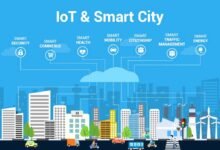
From Sensor to Cloud: A Guide to IoT Data Transmission In 2024? In the ever-evolving landscape of the Internet of Things (IoT), efficient data transmission is the lifeblood that fuels seamless connectivity from sensors to the cloud. This guide dives into the intricacies of IoT data transmission in 2024, exploring the evolution of sensor technology, communication protocols, the role of cloud computing, and addressing challenges through edge computing and 5G technology.
Evolution of Sensor Technology
The journey from traditional sensors to advanced, smart sensors has been remarkable. These sensors play a pivotal role in IoT data transmission by capturing real-time information. As technology progresses, sensors continue to become more sophisticated, providing a wealth of data for various applications.
Communication Protocols in IoT
Selecting the right communication protocol is crucial for effective data transmission in IoT. From MQTT to CoAP, understanding the diverse range of protocols ensures optimal connectivity. This section delves into the significance of protocols and the impact they have on the overall performance of IoT systems.
Cloud Computing in IoT
The integration of cloud computing has revolutionized how IoT data is stored and processed. Cloud-based solutions offer scalability, flexibility, and accessibility, making them indispensable for managing vast amounts of data generated by IoT devices. This section explores the symbiotic relationship between cloud computing and IoT.
Challenges in IoT Data Transmission
Despite the advancements, challenges persist in IoT data transmission. Bandwidth constraints, security issues, and latency concerns pose hurdles. Acknowledging and addressing these challenges is crucial for ensuring the reliability and effectiveness of IoT systems.
Read More: Choosing the Best IoT Protocols: A Practical Guide In 2024
Edge Computing as a Solution
Enter edge computing—a paradigm that brings computation closer to the data source. By processing data locally, edge computing addresses the challenges associated with centralized cloud computing. This section explains how edge computing enhances the efficiency of IoT data transmission.
5G Technology Impact on IoT
The rollout of 5G technology has far-reaching implications for IoT. With increased speed and reduced latency, 5G facilitates faster and more reliable data transmission. This section explores the transformative impact of 5G on IoT applications.
Case Studies
Real-world examples showcase successful implementations of IoT data transmission. From smart cities to industrial applications, these case studies illustrate the practical applications of IoT in diverse sectors.
Future Trends in IoT Data Transmission
Looking ahead, this section predicts the future of IoT data transmission. From AI-driven innovations to the integration of blockchain, emerging technologies will shape the landscape of IoT in the coming years.
Best Practices for Optimizing IoT Data Transmission
To ensure seamless data transmission, adopting best practices is essential. Strategies such as data compression, load balancing, and efficient routing play a crucial role in optimizing IoT systems.
Environmental Considerations
Sustainability is a growing concern, even in the realm of IoT data transmission. This section explores green technologies and eco-friendly practices that contribute to a more sustainable IoT ecosystem.
User Experience and Interface Design
Beyond functionality, the user experience is paramount in IoT applications. This section discusses the importance of a user-friendly interface and explores ways to enhance the overall user experience in IoT data transmission.
Regulatory Compliance
Navigating the complex landscape of regulatory compliance is imperative for IoT deployments. This section provides an overview of regulations impacting IoT data transmission and offers insights into managing compliance challenges.
Security Measures in IoT Data Transmission
The security of IoT systems is non-negotiable. Encryption, authentication, and robust cybersecurity measures are essential to protect against potential threats. This section outlines key security measures for a secure IoT environment.
Conclusion
In conclusion, the journey from sensor to cloud in IoT data transmission is a dynamic and ever-evolving process. Navigating through sensor advancements, communication protocols, cloud computing, and emerging technologies, the key lies in addressing challenges and embracing innovations for a seamless and efficient IoT experience.
FAQs : IoT Data Transmission
How can edge computing improve IoT data transmission?
Edge computing brings computation closer to the data source, reducing latency and enhancing efficiency in IoT data transmission.
What role does 5G play in IoT data transmission?
5G technology facilitates faster and more reliable data transmission, revolutionizing the capabilities of IoT applications.
How can IoT systems ensure regulatory compliance?
Navigating the complex landscape of regulations requires a thorough understanding of the legal framework and proactive measures to comply with standards.
What are the key security measures for IoT data transmission?
Encryption, authentication, and robust cybersecurity practices are crucial for ensuring the security of IoT systems.
How does sustainability factor into IoT data transmission?
Sustainability in IoT data transmission involves adopting green technologies and eco-friendly practices to minimize environmental impact.






